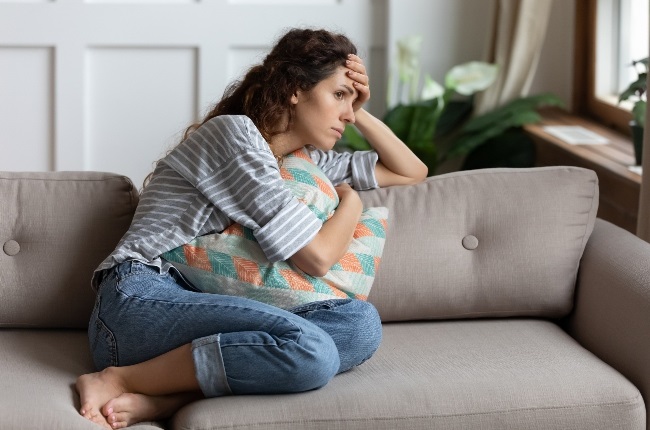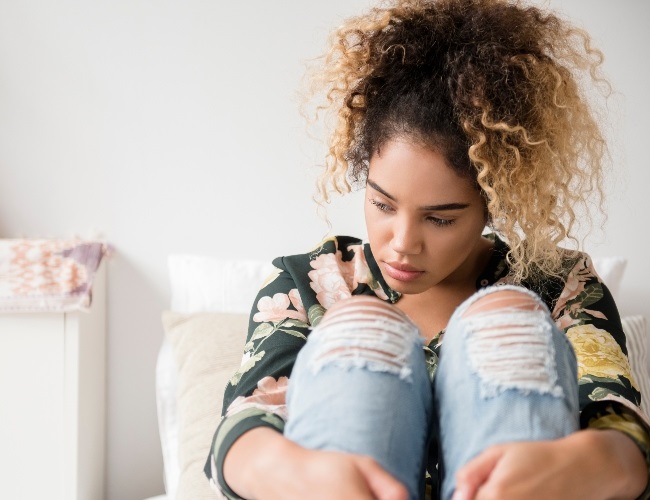
I had been suffering from frightening, debilitating panic attacks almost daily for months before a concerned friend asked me how it was going with my “stress”.
Those who experience panic attacks know it’s not stress. Panic attacks are terrifying and you live in constant fear of the next one, and the next, and the next. When it was at its worst, I’d wake up in a frightful state and the panic would taunt me all day long. Some days I would come close to having an attack, the panic building like gas in a shaken cooldrink bottle while I tried to get on with taking care of my newborn.
I also suffer from depression and had been prescribed a breastmilk-inducing medication that’s also used as an anti-depressant, so I wasn’t worried about using it.
Fast forward a few weeks and the medication hadn’t made any difference to my milk production, so I simply stopped taking it – without informing my gynaecologist.
It was only later that I discovered if you don’t wean yourself off this medication, panic attacks can ensue – and boy, did they.
There were days when the attacks blindsided me, leaving me completely exhausted. The rest of the time I lived in fear of them, feeling the panic building as I got on with the daily tasks of looking after a baby.
I’d had a few panic attacks years before and thanks to a combination of cognitive behavioural therapy (CBT) and antidepressants I’d been free of the crippling fear for a few years.
I dreaded doing that therapy and medication dance again but I knew I had no choice. It was either that or the fear monster would keep me in its grip.
That was six years ago and the antidepressant and CBT were once again a winning combination. I haven’t had an attack in years, although my anxiety has definitely been triggered by the coronavirus and everything it’s brought along with it, as many other anxiety sufferers can attest.
Anxiety disorders affect one in five South Africans, according to the South African Depression and Anxiety Group (Sadag) and they’ve been receiving more calls to their helpline since the start of lockdown.
“Covid-19 and lockdown have had a serious impact on everyone, but especially people living with mental health issues, intensifying their symptoms significantly,” says Dr Colinda Linde, clinical psychologist and Sadag board member from Johannesburg.
“The increase in mental health conditions such as anxiety and depression has led to what’s now being called the second pandemic in the country and worldwide.”
She says the current situation may escalate fear to
crippling levels in those with generalised anxiety disorder (GAD) –
characterised by excessive and extreme worry and always assuming the worst –
and impact those with obsessive compulsive disorder (OCD), who may even feel
their compulsions around cleanliness are justified.
“But everyone has heightened anxiety right now, to the point where it’s becoming trickier to separate clinical anxiety disorders from context-related ones,” Linde says.
Everyone’s story, from how they developed an anxiety disorder to their treatment plan, is unique. Here’s an overview of the various disorders, who’s most at risk and how to deal with a panic attack.
ANXIETY VS ANXIETY DISORDER
Most people experience a feeling of anxiety before an important event such as a big exam, business presentation or first date, Linde says.
Occasional anxiety is normal. It’s the brain’s way of reacting to stress and alerting us to potential danger.
“Anxiety disorders, however, are illnesses that fill people’s lives with over[1]whelming anxiety and fear. It’s chronic, unremitting and can grow progressively worse.
It’s when someone is tormented by obsessive thoughts, flashbacks, nightmares or frightening physical symptoms such as chest pain, heart palpitations and shortness of breath,” she adds.
“The perceived threats cannot be extinguished by someone who has an anxiety disorder – so the ‘fire’ keeps burning,” says Dr Luzuko Magula, a psychiatrist at Ingress Healthcare in Cape Town.
What’s dangerous about this, he adds, is that it can cause sufferers to isolate themselves from friends, family, colleagues or school mates and result in an inability to cope at work or school, lead to excessive stress and the possible loss of jobs and relationships.
IS ANXIETY ON THE RISE?
The increase in awareness about mental health over the years has meant that diagnosis of various disorders has been on the rise, says Magula.
You could liken this to the to the increase in testing during the coronavirus pandemic. “The more testing that’s done, the more positive results there are, the more the community is aware of Covid-19 symptoms, and the more they present themselves to testing stations for screening,” says Magula.
But we’re also generally experiencing more pressure in life,
he adds.
“From bullying and peer pressure at school to pressure in the workplace and the challenges of finding employment in a struggling economy – these things can trigger the development of anxiety disorders in people predisposed to it.”
TYPE ON ANXIETY DISORDERS
Anxiety disorders are characterised by feelings of worry, anxiety or fear that are so intense they interfere with one’s daily activities. It comes in many forms, however, including:
Generalised anxiety disorder (GAD) This is excessive, unrealistic worry and tension that isn’t related to a specific situation and lasts for six months or longer. Those with GAD often anticipate the worst. It’s often accompanied by fatigue, muscle tension, headaches, nausea or trembling.
Panic disorder This is characterised by sudden episodes of intense fear that bring on a panic attack. Physical symptoms include chest pain, heart palpitations, shortness of breath, dizziness, abdominal distress, feelings of unreality and fear of dying. The attacks recur and sufferers develop intense apprehension of having another attack. Someone with panic disorder may develop a phobia about situations where a panic attack has occurred.
Obsessive-compulsive disorder (OCD) This is most commonly characterised by obsessive (repetitive, distressing and intrusive) thoughts and related compulsions (tasks or rituals) which attempt to overcome the obsessions. Those with OCD often realise the ritual makes no sense, but continue doing it nonetheless. The repetitive behaviours are aimed at preventing or reducing distress or preventing a dreaded event or situation.
Phobias Two common phobias are social phobia – an overwhelming fear of scrutiny, embarrassment or humiliation in social situations – and specific phobia, which is an extreme fear of something that poses little or no actual danger
-Remember that although your feelings and symptoms are frightening, they aren’t dangerous or harmful.
-Understand that what you’re experiencing is simply an exaggeration of your body’s normal reaction to stress.
-Don’t fight your feelings or try to wish them away. The more you’re willing to face them, the less intense they’ll become.
-Don’t add to your panic by thinking about what “might” happen. If you find yourself asking, “What if?”, tell yourself, “So what!”
-Remain focused on the present. Notice what’s actually happening to you as opposed to what you think might happen.
-Label your fear level from zero to 10 and watch it fluctuate. Notice that it doesn’t stay at a high level for more than a few seconds.
-When you find yourself getting caught up in fear, change your “what if” thinking. Focus on and carry out a simple and manageable task such as counting backwards from 100 in threes or snapping a rubber band on your wrist.
-Notice that when you stop adding frightening thoughts to your fear, it begins to fade.
-When the fear comes, expect and accept it. Wait and give it time to pass without running away from it.
IT EXISTS ON A SPECTRUM
“Disorders range in severity from mild to severe,” says Magula.
“For example if someone has social anxiety disorder, a mild case would be if their anxiety sometimes impairs functioning at school or work, moderate if it has an effect on both school or work performance and in their social relationships, and severe if they experience anxiety so much of the time that it results in constant problems at work – possibly even job loss – and social isolation.”
WHO’S MOST AT RISK?
There’s no single situation or condition that causes anxiety disorders but rather a combination of physical and environmental triggers that lead to its development. These include:
Adverse childhood experiences such as physical, emotional or sexual abuse.
A genetic predisposition. “Anxiety is a disorder and can affect anyone who has the genetic vulnerability for it, even if they’ve had a problem-free childhood and an objectively good life,” says Linde.
It’s a combination of biology and learned negative thought patterns, so it’s not only associated with past trauma and abuse.
“Being a woman almost doubles your risk of developing an anxiety disorder,” says Magula. “Your risk as a woman increases too if you have a family history of anxiety disorders. In fact, children of people who have at least one anxiety disorder have a two- to fourfold increased risk of developing one.”
Abuse and misuse of drugs and alcohol.
Chronic illnesses such as clinical depression, epilepsy and heart disease can also trigger anxiety disorder if the illness consumes one’s thoughts.
Scientists believe brain chemistry plays a role in the onset of anxiety disorders, as the symptoms are often relieved by medications that alter levels of chemicals in the brain.
It’s been found that people who have low self-esteem and poor coping skills may be prone to anxiety disorders.
On the flip side, an anxiety disorder that begins in childhood may contribute to the development of these traits.
DIAGNOSIS & TREATMENT
Anxiety disorders can develop in childhood, adolescence or early adulthood and if untreated they tend to continue into adulthood and become chronic, says Magula. These disorders need either constant or ad hoc management.
“As the cause of an individual’s anxiety disorder and the management thereof is unique, there’s no ‘cure’ for it,” adds Magula. “Rather, it can be likened to a seasonal flu – if treated, it may go away but perhaps return due to new or persisting triggers.”
When the anxiety “match is lit” once more by a stressor, the strength of the “fire” will be determined by the individual’s protective factors. These include early treatment and support as well as the individual’s resilience and insight into their disorder.
“However, certain measures can be put in place to prevent the development of anxiety. This includes early detection of those who are at risk due to a family history of anxiety disorders or depression and those who’ve been exposed to adverse life events,” says Magula.
“Early and accurate diagnosis can mean an early start to treatment and can prevent a possible future chronic burden.”
Treatment usually combines medication (antidepressants or
benzodiazepines) prescribed by a psychiatrist or GP, and therapy focused on
changing unwanted behaviours or thinking patterns.
CBT may also include exposure therapy where someone gradually works up to facing feared situations.
According to South Africa’s Mental Health Information Centre (MHIC), it’s helpful to have a relationship with the health professional prescribing your medication so treatment can be managed better. This includes looking at whether the medication you’re taking is working for you, how the side effects are affecting you and reviewing these regularly.
Lifestyle changes such as limiting caffeine, alcohol and recreational drugs as well as a regular exercise routine and meditation have been shown to ease symptoms.
“I work with anxiety more than anything else and a lot of people tell me their families don’t know what it’s like to live with high anxiety daily,” says Linde.
Here’s how you can help a loved one who has an anxiety disorder.
It’s important to show empathy. “People with generalised anxiety disorder are often told they worry too much and should just stop it and those with panic disorder are told to snap out of it. This type of reaction tends to come from people who don’t have anxiety and are working from the assumption that the sufferer is choosing to have an anxiety disorder,” Linde says.
“During a panic attack, don’t tell the person to snap out of it – if they could, they would. Rather stay calm, keep your voice even and remind them it’s a panic attack, that although it feels terrible it will pass, and that you’ll stay right there with them. If they’re able to move around or you can distract them, it’s a great help,” Linde suggests.
Help them apply the reality test method to the present situation if they’re up to it – this entails talking through the facts.
The person needs to answer the question, “What are the actual facts in this situation, such as the actual risk factors for me and those around me?” Then they need to focus on a plan for dealing with each risk factor, with emphasis on the solution and not the problem. This is a reminder to focus on what can be controlled – their reaction, right now, versus what’s uncontrollable (others, the past, the future).
Let the person with the disorder set the pace for recovery and be mindful of what you say, says Linde.
Don’t say: “Relax. Calm down. Don’t be anxious. You can fight this. What should we do next? Don’t be ridiculous. Don’t be a coward.”
Do say: “Tell me what you need right now. Breathe slow and low. Stay in the present. I’m proud of you. I know what you’re feeling is painful, but it’s not dangerous. You’re courageous.”
EXTRA SOURCES: SADAG.ORG, THOUGHTSFIRST.COM,
MENTALHEALTHSA.ORG.ZA




 Publications
Publications
 Partners
Partners




















